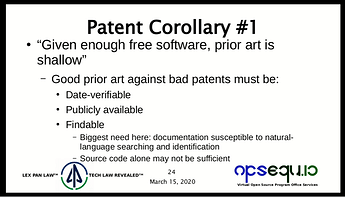RELEASE: 01
There is increasing concern among open source lawyers that software patents held by parties that neither contribute to nor utilize particular open source codebases can and will use their patent portfolios aggressively to extract licensing revenues from vulnerable projects. The nuanced term for such parties is non‑practicing entity (NPE) but they are more colloquially known as patent trolls.
Context
Bain and Smith (2022:215–216) frame the problem this way:
“Although the threat of patent assertions made against Open Source by patent holders who are not participants (via contributions, or via exercising license grants) has been recognized since at least the release of GPLv2 in 1991, it has only been more recently that initiatives involving the Open Source community have been set up to fend off the threat of the use of patents to limit the creation and use of free software.”
One of those defensive measures is assembling a body of prior art — as indicated next.
Prior art
One defensive strategy is to collect and document as much prior art as possible, so that prospective hostile patent applications might fail on examination — or if granted by a national patent office, can be more readily challenged through patent review and civil litigation. Smith (2020:slide 24) explains the task like this:
Hence any documentation related to prior art must therefore be:
- date‑verifiable
- publicly available
- findable by litigants given some level of effort
Projects within the energy domain are certainly not immune to this threat — and should thus record their technical innovations as part of this collective defensive strategy. Hostile patent assertions have historically been made under United States law and there are stepwise tests arising from a series of court rulings on what can and cannot be patented. It is not worth working though those legal details here — but do bear in mind that your documented innovations should be expressed, as far as is possible, in practical rather than abstract terms.
One venue to add potential innovations would be to modify versioned software documentation resident on established code hosting sites — such as GitHub. Another venue would be to create and periodically update a file note for this purpose located on Zenodo together with suitable metadata and keywords.
Risk assessment
It is not necessary to be aware of a particular patent, nor to intend to infringe, to actually infringe and be liable for monetary damages and court‑sanctioned injunctions against further development and distribution. Nor does the patent in question need to be solid — indeed a recent trolling case involving the GNOME desktop concluded with the patent in question being junked following an earlier amicable settlement (OSI Staff 2022).
To date and as far as I am aware, public institutions hosting open source projects have not been targeted by patent trolls. And while there may be reasons as to why such institutions might not make especially attractive targets for patent trolls, there are equally no fundamental reasons why public institutions cannot be attacked using hostile patents and subject to financial coercion.
There are also reasons why numerical modeling is less at risk than other software domains — due to the limited applicability of patent law in this context, the difficulty of securing remedies in the absence of allied hardware and associated supply chains, and the often lack of deep pockets to warrant the pursuit of hostile claims. On that first point of patentability, numerical modeling may be seen as too abstract or too lacking in technical character to fall within scope. Conversely, those working on issues with more commercial merit, such as market simulations or business process designs, are more likely to cover apparently patentable material and thus rate as potential targets.
Closure
Please take this issue seriously and invest some effort into documenting defensive prior art as your contribution to a wider collective insurance policy.
References
Bain, Malcolm and P McCoy Smith (October 2022). Chapter 10: Patents and the defensive response. In Amanda Brock (editor). Open source law, policy and practice (2nd edition). Oxford, United Kingdom: Oxford University Press. ISBN 978-0-19-886234-5. doi:10.1093/oso/9780198862345.003.0010. Pages 213–255. CC‑BY‑NC‑ND‑4.0 license. See in particular §10.4.5 (pages 243–244).
OSI Staff (28 April 2022). GNOME patent troll stripped of patent rights. Voices of Open Source. USA. OSI is Open Source Initiative. CC‑BY‑4.0 license.
Smith, McCoy (15 March 2020). Patents and freedom: where we stand now — LibrePlanet 2020. Boston, Massachusetts, USA: Free Software Foundation (FSF). Archived video. Duration 00:45:36. CC‑BY‑4.0 license.
▢
